Python vector and raster data processing
1.Python processing raster image
1.1 Read tif
import rasterio
from rasterio.plot import show
from matplotlib import colors, cm
rs = rasterio.open(r'C:\Users\lenovo\Desktop\pzh_map_dispose\sf1.tif','r')
result1=rs.read()
1.2 Replace Nodata data
#If the conditions are met, replace it; otherwise, keep it as it is
result=np.where(result1==result1.min(),np.nan,result1)
result
# np.unique(rss[0])
out:
array([[[nan, nan, nan, ..., nan, nan, nan],
[nan, nan, nan, ..., nan, nan, nan],
[nan, nan, nan, ..., nan, nan, nan],
...,
[nan, nan, nan, ..., nan, nan, nan],
[nan, nan, nan, ..., nan, nan, nan],
[nan, nan, nan, ..., nan, nan, nan]]])
1.3 Display TIF
import geopandas as gpd
shp = gpd.read_file(r"C:\Users\lenovo\Desktop\pzh_map_dispose\pzh_city.shp")
fig, ax = plt.subplots(figsize=(5,9))
shp.plot(ax=ax,color='none')
show(result, transform=rs_mask.transform,ax=ax, cmap='gist_earth')
fig.colorbar(cm.ScalarMappable(norm=colors.Normalize(vmin=np.nanmin(result), vmax=np.nanmax(result)), cmap='gist_earth')
, ax=ax,extend='both',fraction=0.05)
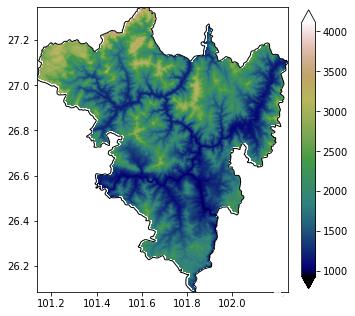
2.An example from scratch - full version
2.1 Create shp faces and write files
import os
import geopandas
from shapely import geometry
import matplotlib.pyplot as plt
x1,y1=30,30
x2,y2=50,50
# Corresponds to Polygon in shapely.geometry, which is used to represent faces. Next, we create a polygon object composed of several Polygon objects
cq = geopandas.GeoSeries([geometry.Polygon([(x1,y1), (x2,y1), (x2,y2), (x1,y2)]),
geometry.Polygon([(x2,y1),(55,40), (x2,y2)])
],
index=['1', '2'], # Build an index field
crs='EPSG:4326', # The coordinate system is WGS 1984
)
cq.to_file(r'simple_poly.shp',
driver='ESRI Shapefile',
encoding='utf-8')
cq

2.2 Read using geopandas
gdf=geopandas.read_file(r'simple_poly.shp')
gdf
gdf.plot(column='index')
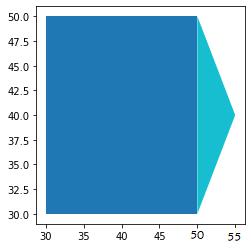
2.3 Convert to grid - convert to grid according to field
# Vector data to grid: no template required
def shpToRaster2(shp_path,raster_path,cellsize,field):
'''
Vector data to grid: No template required
:param shp_path:Vector data to be converted
:param raster_path:Grid save path after export
:param cellsize:Cell size
:param field:Vector data field as grid value
:return:
'''
shp = ogr.Open(shp_path)
m_layer = shp.GetLayer()
extent = m_layer.GetExtent()
Xmin = extent[0]
Xmax = extent[1]
Ymin = extent[2]
Ymax = extent[3]
rows = int((Ymax - Ymin)/cellsize);
cols = int((Xmax - Xmin) / cellsize);
GeoTransform = [Xmin,cellsize,0,Ymax,0,-cellsize]
target_ds = gdal.GetDriverByName('GTiff').Create(raster_path, xsize=cols, ysize=rows, bands=1, eType=gdal.GDT_Float32)
target_ds.SetGeoTransform(GeoTransform) target_ds.SetProjection(str(pro)) # Get projection must be converted to string
band = target_ds.GetRasterBand(1)
pro = m_layer.GetSpatialRef()
band.SetNoDataValue(-999)
band.FlushCache()
# target_ds.SetProjection('GEOGCS["GCS_China_Geodetic_Coordinate_System_2000",DATUM["China_2000",SPHEROID["CGCS2000",6378137,298.257222101]],PRIMEM["Greenwich",0],UNIT["degree",0.0174532925199433,AUTHORITY["EPSG","9122"]],AXIS["Latitude",NORTH],AXIS["Longitude",EAST]]') gdal.RasterizeLayer(target_ds, [1], m_layer, options=["ATTRIBUTE=%s"%field,'ALL_TOUCHED=TRUE']) # Assign value to grid pixel with shp field
del target_ds
shp.Release()
vector_fn=r'simple_poly.shp'
raster_fn=r'two_region.tif'
shpToRaster2(vector_fn,raster_fn,cellsize=0.5,field='index')
2.4 Display raster image
def showraster(inputtif): import rasterio from rasterio.plot import show from matplotlib import colors, cm rs =rasterio.open(inputtif)
rss=rs.read() #If the conditions are met, replace it; otherwise, keep it as it is result=np.where(rss==rss.min(),np.nan,rss) fig, ax = plt.subplots(figsize=(4,4)) show(result, transform=rs.transform,ax=ax, cmap='cool') from mpl_toolkits.axes_grid1 import make_axes_locatable divider = make_axes_locatable(ax) cax = divider.append_axes("right", size="3%", pad=0.1) # world.plot(column='pop_est', ax=ax, legend=True, cax=cax) fig.colorbar(cm.ScalarMappable(norm=colors.Normalize(vmin=np.nanmin(result), vmax=np.nanmax(result)), cmap='cool') , ax=ax,extend='both',fraction=0.010,cax=cax) return fig,ax showraster(r'two_region.tif')
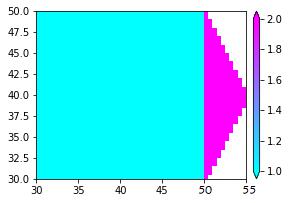
2.5 Create a mask shape
import os
import geopandas
from shapely import geometry
import matplotlib.pyplot as plt
# Corresponds to Polygon in shapely.geometry, which is used to represent faces. Next, we create a polygon object composed of several Polygon objects
cq = geopandas.GeoSeries(geometry.Polygon([(47,35),(53,35),(54,48),(45,45)]),
index=['1'], # Build an index field
crs='EPSG:4326', # Coordinate system: WGS 1984
)
cq.to_file(r'simple_mask.shp',
driver='ESRI Shapefile',
encoding='utf-8')
gdf=geopandas.read_file(r'simple_mask.shp')
gdf.plot()
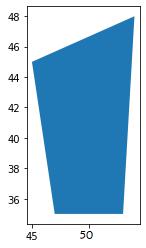
2.6 Simultaneous display
def showraster2(inputtif,inputshp):
import rasterio
from rasterio.plot import show
from matplotlib import colors, cm
rs =rasterio.open(inputtif)
rss=rs.read()
#If the conditions are met, replace it; otherwise, keep it as it is
result=np.where(rss==rss.min(),np.nan,rss)
shp = gpd.read_file(inputshp)
fig, ax = plt.subplots(figsize=(4,4))
shp.plot(ax=ax,color='none')
show(result, transform=rs.transform,ax=ax, cmap='cool')
from mpl_toolkits.axes_grid1 import make_axes_locatable
divider = make_axes_locatable(ax)
cax = divider.append_axes("right", size="3%", pad=0.1)
# world.plot(column='pop_est', ax=ax, legend=True, cax=cax)
fig.colorbar(cm.ScalarMappable(norm=colors.Normalize(vmin=np.nanmin(result), vmax=np.nanmax(result)), cmap='cool', ax=ax,extend='both',fraction=0.010,cax=cax))
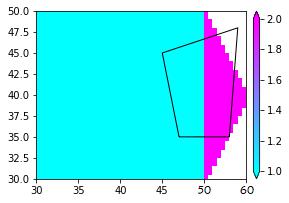
2.7 Mask extraction
# Use the mask above to extract the grid
def shp_mask(inputtif,inputshp,outtif):
import fiona
import rasterio
import rasterio.mask
rs = rasterio.open(inputtif,'r')
with fiona.open(inputshp, "r") as shapefile:
shapes = [feature["geometry"] for feature in shapefile]
out_image, out_transform = rasterio.mask.mask(rs,shapes,crop=True)
out_meta = rs.meta
out_meta.update({"driver": "GTiff",
"height": out_image.shape[1],
"width": out_image.shape[2],
"transform": out_transform})
with rasterio.open(outtif, "w", **out_meta) as dest:
dest.write(out_image)
inputtif=r'two_region.tif'
inputshp=r'simple_mask.shp'
outtif=r'tif_mask.tif'
shp_mask(inputtif,inputshp,outtif
2.8 Result display
showraster2(r'tif_mask.tif',r'simple_mask.shp')
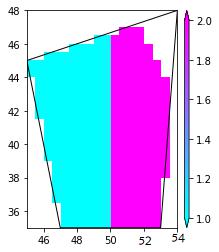
3 Extract grid data based on points
3.1 The first method
import geopandas
import rasterio
import matplotlib.pyplot as plt
from shapely.geometry import Point
# Create sampling points
points = [Point(101.4, 27.0), Point(101.6,26.6), Point(101.6,26.8), Point(102.0,27)]
gdf = geopandas.GeoDataFrame([1, 2, 3, 4], geometry=points, crs=4326)
src = rasterio.open(r'C:\Users\lenovo\Desktop\pzh_map_dispose\sf1.tif','r')
result1=src.read()
#If the conditions are met, replace it; otherwise, keep it as it is
result=np.where(result1==result1.min(),np.nan,result1)
result
# np.unique(rss[0])
from rasterio.plot import show
from matplotlib import colors, cm
fig, ax = plt.subplots()
# # transform rasterio plot to real world coords
# extent=[src.bounds[0], src.bounds[2], src.bounds[1], src.bounds[3]]
ax = rasterio.plot.show(src,ax=ax, cmap='gist_earth')
gdf.plot(ax=ax,color='red')
fig.colorbar(cm.ScalarMappable(norm=colors.Normalize(vmin=np.nanmin(result), vmax=np.nanmax(result)), cmap='gist_earth', ax=ax,extend='both',fraction=0.05))
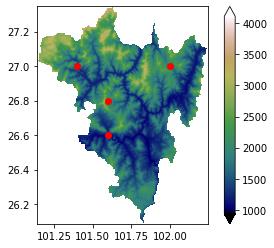
coord_list = [(x,y) for x,y in zip(gdf['geometry'].x , gdf['geometry'].y)]
coord_list
gdf['value'] = [x for x in src.sample(coord_list)]
gdf.head()
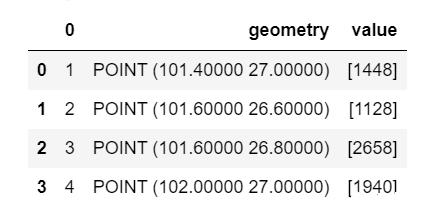
3.2 The second method
from rasterstats import gen_point_query
pointData=gdf
point_raster_value=gen_point_query(pointData['geometry'],r'C:\Users\lenovo\Desktop\pzh_map_dispose\sf1.tif')
print(*point_raster_value)